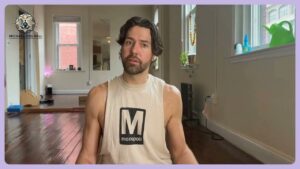Video: Ashtanga Vinyasa Inspired Power Yoga and Breathwork
This is class is 75 minutes. It is a bit of third, second, and first. We begin with a nice alternate nostril pranayama

This is class is 75 minutes. It is a bit of third, second, and first. We begin with a nice alternate nostril pranayama
75 Minutes
6:12:12:6 grower pranayama
Touch & Go Standing
Intermediate A
Advanced A
Primary Marichi
Maitri Meditation

Michael Joel Hall discusses his intervention strategies to address unhealthy group dynamics in Ashtanga Yoga practice. He emphasizes the need for critical thinking, encouraging student autonomy, and fostering an open, transparent, and inclusive environment. Hall advocates for a student-centric approach, prompting open dialogue, respecting individual choices, and avoiding hierarchical or dogmatic practices. He stresses the importance of evidence-based teaching, open leadership, and peer support. Hall highlights the necessity of maintaining ethical standards, respecting personal autonomy, and fostering genuine community connections without creating high-pressure commitments or abusive dynamics. The script underscores the significance of maintaining integrity, transparency, and community well-being in yoga teaching and leadership.
00:00 Introduction and Purpose
00:01 Addressing Unhealthy Group Dynamics
01:15 Critical Thinking in Yoga Practice
01:40 Encouraging Student Independence
02:26 Building Trust and Normalizing Doubt
02:57 Grounding Practice in Biomechanics
04:57 Fostering Democratic Leadership
05:40 Being Open to Oversight
07:00 Respecting Personal Choices
07:28 Avoiding Dogmatic Views
07:44 Promoting Inclusivity and Accessibility
08:36 Equal Standards and No Inner Circles
09:26 Transparency and Ethical Standards
18:10 Authentic Relationships Beyond Yoga
18:58 Financial Transparency and Community Support
19:44 Avoiding Abuse and Humiliation
21:17 Ethical Mentorship and Equity
23:13 Maintaining Integrity and Being Yourself
26:10 Community Membership as a Practice
26:51 Transparency in Teaching and Learning
28:56 Data-Driven Success and Community Impact
29:38 Personal Challenges and Community Support
30:10 Long-Term Practice and Growth
30:27 Adapting and Innovating in Yoga
30:58 Conclusion and Farewell

In this video, Michael Joel Hall explores the concept of self-awareness through the practice of yoga. He discusses how physical patterns observed during yoga can mirror deeper mental models affecting our life experiences. Hall encourages understanding not just what we do, but why we do it, by relating the approach to challenging yoga postures with how we handle life’s challenges. He outlines how beliefs manifest in actions and outcomes, and emphasizes the transformative power of awareness. Practical tools such as morning check-ins, pattern journaling, body scans, and mindful transitions are suggested to deepen self-awareness. Hall also highlights the importance of community in accelerating growth and understanding our broader impact on the world. The video invites viewers to start their own journey of self-observation and build a foundation of awareness for personal transformation.
00:00 Introduction to Self-Awareness
00:24 The Mirror of Practice
00:48 Breaking Down Mental Models
01:23 Practical Steps for Self-Awareness
02:37 Tools and Community Support

Title: Harnessing Energy in Ashtanga Yoga: From Grounding to Expansion
—
**Introduction to Energy Management in Ashtanga Yoga**
Hello, hello, hello! Michael Hall here, and today I want to share some insights on managing your energy within the practice of Ashtanga Yoga. This practice transcends the physical; it’s an intricate system working harmoniously with your nervous and energetic systems. The sequence of postures is methodically designed to guide prana—your life force—through the body, balancing effort with ease and integrating activation with relaxation.
—
**Understanding the Primary Series**
Each series in Ashtanga has a deliberate arc, beginning with the Primary Series. This series is all about building stability—it wrings out the body, ensuring your hips and shoulders can twist and your spine can move freely. Beyond its physicality, the Primary Series teaches you how to ground yourself, directing your prana downwards into the earth, known as Ana. This foundational grounding is crucial as it sets the stage for understanding the upward rising energies in later series.
—
**Exploring the Intermediate Series**
Progressing into the Intermediate Series, the practice shifts focus to an upward energy flow. This series activates your internal awareness and internal rotations, requiring greater breath regulation and a sharper mental focus. It’s not just about moving energy up; it’s about mastering the internal aspects of your practice to cultivate an expansive, inward journey.
—
**Advancing to the Advanced Series**
Carrying the principles of the previous series forward, the Advanced Series amplifies both strength and the feeling of lightness and expansion. These poses are wildly intense, demanding refined control to maintain ease amidst the challenge. This series is about finding balance through strength, enhancing your ability to manage energy in demanding postures.
—
**Optimizing Energy in Practice**
Practicing multiple series calls for energy optimization, not merely endurance. Some practitioners fall into the trap of overexerting early on, leaving little energy for later postures. Effective energy management involves using your breath to contain and channel prana wisely, avoiding unnecessary leakage of effort that leads to exhaustion.
—
**Breath Control and Pacing**
Maintaining a steady breath is vital, as erratic breathing can quickly drain your energy. Mastering breath control requires pacing your intensity, resisting the urge to push too early, thereby maintaining balance and ensuring consistent energy throughout your practice.
—
**Self-Regulation and Wise Energy Use**
The structure of Ashtanga Yoga is self-regulating, teaching practitioners to use their energy wisely. The challenge lies not just in your physical capacity to perform each posture, but in learning to harness your energy efficiently so that your practice becomes an energizing, rather than exhausting, experience.
—
**Conclusion: Energizing Your Practice**
Ultimately, the goal of energy management in Ashtanga Yoga is to leave practice feeling energized, not depleted. By understanding the arcs of each series, utilizing breath control, and pacing your intensity, you harness your energy effectively, fortifying the union of body, mind, and spirit.
Embrace the journey of mastering your energy in Ashtanga Yoga, and transform your practice into a source of vitality and inner balance.

In this video, Michael Joel Hall delves into the concept that obstacles are not roadblocks but integral parts of our spiritual journey. Drawing from personal experiences and teaching observations, he explores how challenges serve as profound teachers, revealing our limiting beliefs and building spiritual strength. Hall explains the different types of obstacles, both external and internal, and emphasizes the importance of perspective in transforming these challenges into opportunities for growth. He highlights how obstacles can guide us toward our dharma and deepen our understanding.
00:00 Introduction: Embracing Obstacles for Spiritual Growth
00:24 Understanding the Nature of Obstacles
01:04 The Spiritual Purpose of Challenges
01:37 Approaching Obstacles as a Spiritual Practice

In this video, Michael Joel Hall discusses the importance of integrating all eight limbs of Ashtanga yoga, rather than focusing solely on the physical practice of asanas. He addresses the potential pitfalls of modern practices, such as the risk of turning yoga into just another workout, the impact of social media on the practice, and the ethical dilemmas faced in a performance-driven culture. Hall advocates for a more comprehensive approach that includes elements like meditation, ethical study, and understanding of foundational texts to truly cultivate a holistic yoga practice.
00:00 Introduction to Modern Ashtanga Yoga
00:08 Criticism and Holistic Approach
00:44 Ethical Dilemmas in Social Media
01:18 Integrating All Eight Limbs
01:31 Conclusion